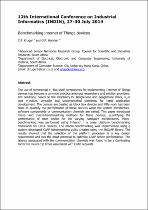JavaScript is disabled for your browser. Some features of this site may not work without it.
- ResearchSpace
- →
- Research Publications/Outputs
- →
- Conference Publications
- →
- View Item
| dc.contributor.author |
Kruger, Carel P

|
|
| dc.contributor.author |
Hancke, GP

|
|
| dc.date.accessioned | 2015-10-15T07:58:58Z | |
| dc.date.available | 2015-10-15T07:58:58Z | |
| dc.date.issued | 2014-07 | |
| dc.identifier.citation | Kruger, C,P and Hancke, G,P. 2014. Benchmarking Internet of Things devices. In: Industrial Informatics (INDIN), 2014 12th IEEE International Conference on, 27-30 July | en_US |
| dc.identifier.uri | http://ieeexplore.ieee.org/xpls/abs_all.jsp?arnumber=6945583&tag=1 | |
| dc.identifier.uri | http://hdl.handle.net/10204/8180 | |
| dc.description | Industrial Informatics (INDIN), 2014 12th IEEE International Conference on, 27-30 July 2014. Due to copyright restrictions, the attached PDF file only contains the abstract of the full text item. For access to the full text item, please consult the publisher's website | en_US |
| dc.description.abstract | The use of commercial off-the-shelf components for implementing Internet of Things devices has become a common practice amongst researchers and solution providers. IOT solutions, based on the Raspberry Pi, BeagleBone and BeagleBone Black, offer cost effective, versatile and uncomplicated platforms for rapid application development. The devices are treated as black box devices and little work has been done to quantify the performance of these devices when the system architecture, software components or communication channels are varied. This paper introduces micro- and macro-benchmarking methods for these devices; quantifying the performance of each device for the varying hardware architectures. Micro-benchmarking was performed using lmbench - a cross platform benchmarking framework for UNIX devices. The macro-benchmarking was implemented using a custom developed CoAP benchmarking utility created using the libCoAP library. The results showed that the selection of the platform processor is a key design requirement and has the most potential to optimise CoAP server performance. The latency associated with the communication channels was found to be a dominating factor for round-trip times associated with CoAP requests. | en_US |
| dc.language.iso | en | en_US |
| dc.publisher | IEEE | en_US |
| dc.relation.ispartofseries | Workflow;14650 | |
| dc.subject | Internet of Things | en_US |
| dc.subject | IoT | en_US |
| dc.subject | Wireless Sensor Networks | en_US |
| dc.subject | Benchmarking | en_US |
| dc.subject | Commercial of-the-shelf | en_US |
| dc.title | Benchmarking Internet of Things devices | en_US |
| dc.type | Conference Presentation | en_US |
| dc.identifier.apacitation | Kruger, C. P., & Hancke, G. (2014). Benchmarking Internet of Things devices. IEEE. http://hdl.handle.net/10204/8180 | en_ZA |
| dc.identifier.chicagocitation | Kruger, Carel P, and GP Hancke. "Benchmarking Internet of Things devices." (2014): http://hdl.handle.net/10204/8180 | en_ZA |
| dc.identifier.vancouvercitation | Kruger CP, Hancke G, Benchmarking Internet of Things devices; IEEE; 2014. http://hdl.handle.net/10204/8180 . | en_ZA |
| dc.identifier.ris | TY - Conference Presentation AU - Kruger, Carel P AU - Hancke, GP AB - The use of commercial off-the-shelf components for implementing Internet of Things devices has become a common practice amongst researchers and solution providers. IOT solutions, based on the Raspberry Pi, BeagleBone and BeagleBone Black, offer cost effective, versatile and uncomplicated platforms for rapid application development. The devices are treated as black box devices and little work has been done to quantify the performance of these devices when the system architecture, software components or communication channels are varied. This paper introduces micro- and macro-benchmarking methods for these devices; quantifying the performance of each device for the varying hardware architectures. Micro-benchmarking was performed using lmbench - a cross platform benchmarking framework for UNIX devices. The macro-benchmarking was implemented using a custom developed CoAP benchmarking utility created using the libCoAP library. The results showed that the selection of the platform processor is a key design requirement and has the most potential to optimise CoAP server performance. The latency associated with the communication channels was found to be a dominating factor for round-trip times associated with CoAP requests. DA - 2014-07 DB - ResearchSpace DP - CSIR KW - Internet of Things KW - IoT KW - Wireless Sensor Networks KW - Benchmarking KW - Commercial of-the-shelf LK - https://researchspace.csir.co.za PY - 2014 T1 - Benchmarking Internet of Things devices TI - Benchmarking Internet of Things devices UR - http://hdl.handle.net/10204/8180 ER - | en_ZA |






